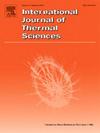Numerical simulation of thermal transfer in polyimide nanofiber aerogels by 3D dual diameter Voronoi models
IF 4.9
2区 工程技术
Q1 ENGINEERING, MECHANICAL
International Journal of Thermal Sciences
Pub Date : 2025-04-29
DOI:10.1016/j.ijthermalsci.2025.109941
引用次数: 0
Abstract
The investigation of heat transfer in nanofiber aerogels (NFAs) is crucial for predicting and designing aerogels that achieve desirable thermal performances for various industrial applications. However, limited research has been conducted on numerical modeling of NFAs due to the challenges associated with reconstructing their structure. In this work, we present a 3D dual diameter Voronoi model to evaluate the thermal conductivity of NFAs. As an example, polyimide NFAs are considered. The predicted thermal conductivity values show good agreement with various experimental data with all relative errors being less than 5%. Furthermore, several influential parametric factors including the nanofiber diameter, the ratio between different diameters nanofibers and the structure of nanofibers are investigated. The results indicated that the thermal conductivity of NFAs increase with both the nanofiber diameter and the ratio of coarse nanofibers. Additionally, the intersection between coarse and fine nanofibers which along with the heat transfer direction and the location will influences the thermal conductivity of NFAs. This certainly demonstrates the potential of the dual diameter Voronoi model for use in the predicting and designing of the NFAs in the various fields such as thermal insulation or the energy management.
基于三维双直径Voronoi模型的聚酰亚胺纳米纤维气凝胶传热数值模拟
研究纳米纤维气凝胶(nfa)的传热对于预测和设计具有理想热性能的气凝胶具有重要意义。然而,由于其结构重建的挑战,对非接触网的数值模拟研究有限。在这项工作中,我们提出了一个三维双直径Voronoi模型来评估nfa的导热性。以聚酰亚胺nfa为例。预测的导热系数值与各种实验数据吻合较好,相对误差均小于5%。此外,还研究了纳米纤维直径、不同直径的纳米纤维之比以及纳米纤维的结构等参数对纳米纤维性能的影响。结果表明,纳米纤维的导热系数随纳米纤维直径和粗纤维配比的增加而增加。此外,粗、细纳米纤维的交点以及传热方向和位置也会影响纳米纤维的导热性。这无疑证明了双直径Voronoi模型在预测和设计诸如隔热或能源管理等各个领域的nfa方面的潜力。
本文章由计算机程序翻译,如有差异,请以英文原文为准。
求助全文
约1分钟内获得全文
求助全文
来源期刊

International Journal of Thermal Sciences
工程技术-工程:机械
CiteScore
8.10
自引率
11.10%
发文量
531
审稿时长
55 days
期刊介绍:
The International Journal of Thermal Sciences is a journal devoted to the publication of fundamental studies on the physics of transfer processes in general, with an emphasis on thermal aspects and also applied research on various processes, energy systems and the environment. Articles are published in English and French, and are subject to peer review.
The fundamental subjects considered within the scope of the journal are:
* Heat and relevant mass transfer at all scales (nano, micro and macro) and in all types of material (heterogeneous, composites, biological,...) and fluid flow
* Forced, natural or mixed convection in reactive or non-reactive media
* Single or multi–phase fluid flow with or without phase change
* Near–and far–field radiative heat transfer
* Combined modes of heat transfer in complex systems (for example, plasmas, biological, geological,...)
* Multiscale modelling
The applied research topics include:
* Heat exchangers, heat pipes, cooling processes
* Transport phenomena taking place in industrial processes (chemical, food and agricultural, metallurgical, space and aeronautical, automobile industries)
* Nano–and micro–technology for energy, space, biosystems and devices
* Heat transport analysis in advanced systems
* Impact of energy–related processes on environment, and emerging energy systems
The study of thermophysical properties of materials and fluids, thermal measurement techniques, inverse methods, and the developments of experimental methods are within the scope of the International Journal of Thermal Sciences which also covers the modelling, and numerical methods applied to thermal transfer.
 求助内容:
求助内容: 应助结果提醒方式:
应助结果提醒方式:


